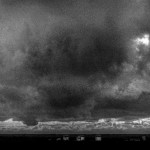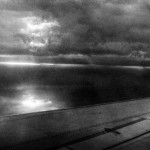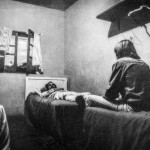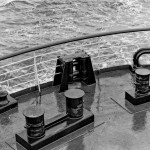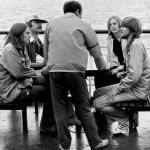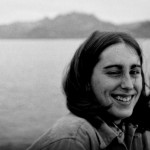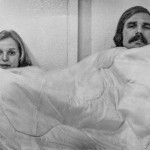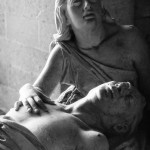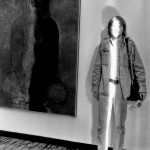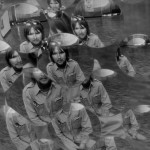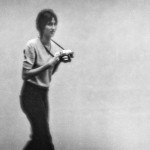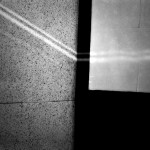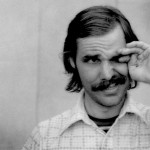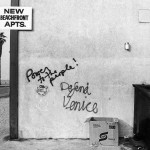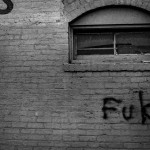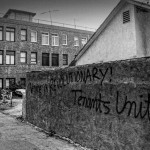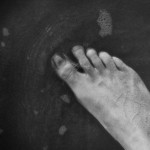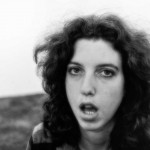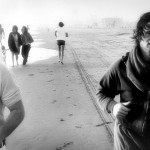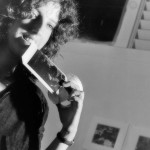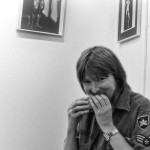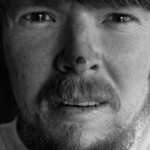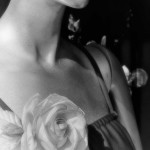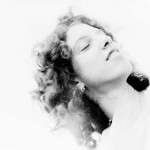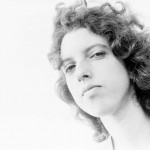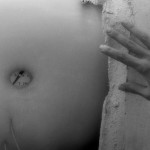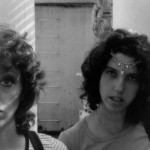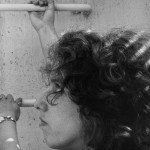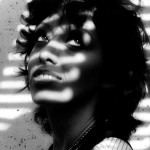Category: early b&w
New York – November 1974
From the previously-unknown negative archives. One of my many side trips to NYC, this time a few days with my brother and family in the then-largely ungentrified West Village, and to see a couple of photographer friends.
Mexico (1974)
Or, mas cerveza por favor …
About two or three days before Christmas in 1974, I was party to a rash, impulsive and ultimately ill-advised decision to immediately spend the holidays in Mexico.
Packing little more than a change of socks and underwear, a sweater, and plenty of film, along with camera, of course, my photography cohorts Bill (you’ve met him before) and Mike, departed LAX airport for an initial destination of La Paz, near the southern end of the Baja California peninsula.
With no reservations or any measure of planning, we made for the nearest hotel with a vacancy, La Paz Central, an extraordinarily seedy but inexpensive lodging. One night is enough.
A bad night’s sleep, walk around the streets and beach, and we decide to take the ferry on Christmas Eve to leave La Paz behind and seek out Mazatlan on the mainland. The weather turns cold …
The La Paz-Mazatlan ferry is our home for the next 16 or 18 hours, as we cruise across the Sea of Cortez, aka Gulf of California. Many passengers have booked and filled sleeping cabins, so we are left to spend the night crossing on the open deck, sharing space with a handful of night-owls or budget-challenged folk.
Once aboard the ferry, we meet two Dutch world travelers. In a striking gesture of international goodwill, the girls offer to share their sleeping bags with us for warmth. (This, after a measure of time during which they feigned the inability to speak English, or even Spanish, until they had apparently decided that we were merely harmless American fools.) The next many hours were spent passing the tequila bottle around that we had wisely brought aboard, talking and laughing, taking many photographs, solving world problems and trying to catch a few minutes of snooze here and there. It became so cold that everyone brought out all of their extra clothing and totally layered up; Mike took this to the extreme and ended up with a set of boxer shorts worn outside his other clothes. Eventually, Bill loosened up and crawled onto the dog-pile under the sleeping bags to fend off the chill.
Even if we had been able to sleep, we would not have missed the sighting of land in the early morning. Many passengers were up on the deck to join us in greeting the sunrise.
I believe we have a few photos of our brief encounter with Mazatlan (below), but here’s where the document trail goes mostly cold. Following vigorous debate, we decide to press for Mexico City. I clearly recall a terrifying bus ride along a coastal cliff road, then on to higher country and jungle. At Guadalajara, we transfer to a much more modern, but ultimately ill-fated bus for perhaps 12 hours to Mexico City. Within an hour of our departure, that bus’ onboard bathroom became unusable. Wouldn’t have been a complete show stopper, but it seems that our travel companion Mike was suffering from something that he had eaten earlier … Only Yankee ingenuity — the details of which shall be withheld — somewhat saved the day over the next … day.
So while I continue to search for the negatives chronicling the bus travel adventure, we suddenly find ourselves in Mexico City. We stayed in a sort of bed & breakfast that claimed to have once been the lodging of Leon Trotsky (if you don’t remember how he ended up in Mexico, and ended up, I recommend that you see the 1972 “Assassination of Trotsky” film, the 2002 “Frida” film and/or the Mexican “The Chosen”, said to be in production as of 2015, and not to be confused with any number of other films with the same name). So we visited an art gallery, the museum of anthropology (with claims of the best/biggest collection of pre-columbian artifacts anywhere) and Maximillian’s Palace.
Christmas night propounded the agony when our Christmas night dinner left almost everyone ill, myself least stricken as I had judiciously and assiduously substituted tequila for water on all occasions, and, regrettably, most affected was again Mike. As soon as we visited local farmacias the next morning for some stopgap measures, we attempted to immediately fly home. Finding that the quickest way out during the Christmas logjam was back via Guadalajara, we backtracked by bus — a most miserable experience — and eventually touched down, by virtue of a much more satisfactory Aeromexico expedient, in Los Angeles. Again, documentation on this leg is missing but may still exist, somewhere, in my negative archives.
Venice, 1970s: More
A Slice of 1977 Venice History
Living in Venice for several years in the 70s afforded much opportunity to come in contact with many of the artists who gave the place some of its flavor. Among these would be the Mother Art collective (one of whose co-founders, Laura, went on to team up with my brother Dennis). Here are some miscellaneous photos of local artists and other scenes from 1977, previously unseen, that I blundered upon yesterday in my archives of unprocessed negatives. Following that, a trailer from Mother Art’s acclaimed video.
And, here’s the Mother Art video trailer:
Desolation Row – Los Angeles, 1973
I don’t know if I could ever find this place again, and it surely can’t look like it did in late 1973. My friend, a small-time real-estate speculator, took me to this no man’s land of a short stretch of beach hillside in the LAX airport flyover zone. He pointed out that this was beachfront property at wildly bargain prices. The day of our visit was accompanied by stifling heat and smog and Santa Ana winds that only punctuated the bleakness of the mostly-unlandscaped and barely populated area. Every few seconds a jet would blast away our conversation. Where was this? Perhaps just west of El Segundo, or maybe a bit north of that? Google Maps?
The Great Tunafish Expedition, Probably 1973
[Excerpted from a posting originally intended for my photo blog]
It all started with the Banquet Camera. Kodak (and others like Folmer-Schwing) made these things during the latter part of the 19th century and well into the 20th. Bill found one somewhere in a back room of a camera store in Lakewood, if I recall. Bill, my old photography sidekick and surfing/auto racing/sports magazine shutter for hire, is pictured here in portraits I made in Arizona in 1973 and while shooting in Death Valley in 1976.
And while we are at it, here is a most wonderful image captured of Bill in 2004 by one of his Los Angeles shooter friends, whose name I do not recall.
Bill’s Banquet Camera was a large wooden view camera requiring film in the 10×20 (or was it 12×20?, and that’s inches) format, and was literally designed to photograph large groups in banquet halls in a single panoramic view. Some examples follow; thanks Google!

Bill put all of his natural and acquired skills together — from his experience as a camera repair person for a large camera store in Long Beach to that of serving as a (sometimes ride-along) helicopter mechanic in VietNam — and sufficiently restored the beast to an operational state. The rub was that he had no film for it, but he contacted Eastman Kodak, still alive and well and thriving in Rochester, New York and was told they would look into the matter. When he received a callback in a couple of days advising that they did indeed have some old stock and were willing to negotiate a price, we hit upon a plan to drive there as soon as possible and retrieve the stuff, and shoot large-format all the way home.
Some of you may recall that Bill was head photographer for International Surfing Magazine when I met him in 1968 or 69 or 70. Growing up in Long Beach near the coast and with a father who headed up the aircraft maintenance department at Long Beach Airport, Bill was into both flying and surfing. And somehow photography came along as that was the only thing he liked in school. As we realized that we needed another person to split the cost of gas to New York, we approached Michael, a surfer and appreciator, but non-participant, in things photographic. He agreed, on the condition that we would take surfboards and hit the waves on the East Coast. So as Bill and Michael started planning a surfing itinerary, I made contact with a group of photographers I knew in upstate New York who transformed a farm there into a photography and art education-oriented commune, thereby establishing my way of spending three or four weeks while the others would crawl the East Coast looking for the Big One.
I serviced my 1971 VW camper in anticipation of the trek, and we started accumulating a few necessities to take along. Turned out that a friend of Bill who often dropped into Bill’s studio/darkroom was a State of California employee charged with inspection of food processing facilities. This guy would come by with his longhaired Afgan Hound, grooming the thing while having a beer with us and seeming to hope that we would photograph the dog (which did happen), and regaling us with horror stories of food processing observations. When he learned that we were planning a cross-country trip on a tight budget, he dropped off something that he had been given (was it a bribe? a remainder?) at his most recent inspection gig. It was a case of Chicken of the Sea tuna in oil, which he suggested would stow easily in the VW. 
By the time we reached Texas, we had become so repulsed by the stuff that we vowed never to touch it again — ever. Nevertheless, we kept the unopened cans in the event of some sort of emergency — we did consider this a perilous, high risk journey — but when we broke down and desperately opened some in, was it New Jersey, the smell almost instantly sickened all of us.
So we ultimately made it to Rochester and bought film, but it was too hard to manage on the road in our cramped transport. Thus we only photographed with 35mm cameras and a “small” 4×5 view camera. Tons of photographs were actually taken throughout the trip, but for now I can only locate ones documenting small portions of the junket. Bill and Michael went on to surf in places like Cape Cod, while I dived deeply into photography at the upstate commune (I know that I have some negatives on that). Here are some evidences of activity in and around Washington, D.C., on our approach leg, most of questionable value:
Also we have some mostly nondescript images from New York and on into New England. I should mention that we did something that would be almost unimaginable in this era. We solved the difficulty of finding camping grounds in NYC by driving out to the La Guardia airport parking lot at night, drawing lots to see which lucky person would sleep inside the bus and which two underneath it. Our time there was brief, despite my desire to spend more time in arguably my favorite city in the US, but Bill and Michael wanted to push on to drop me off upstate so they could get cracking in the surf.
More to follow, almost certainly, but don’t expect any coherent order or even decent image quality.
The Gingles Farm, 1973
Doc Gingles was our family doctor for a period during my childhood. He was a rotund, jolly character with an exceptional bedside manner (he used to remind me of Burl Ives, for those old enough to recollect that folk singer; he reminded others of Santa Claus; my sister, if I recall, was terrified of him). The doctor and his sister (unlike her brother, she was a stern, humorless person) were wealthy property owners in the county.
Around 1950, my parents rented a sizeable farm from the Gingles sister in the river valley and surrounding hills across from the tiny town of Castana, Iowa. We lived there for a few years during an era of much significance — the summer of polio, the Korean War, the rise of Stalin’s brand of Communism, among others — all riveting to the mind of a youngster, pre-adolescent, pre-teen.
On a VW bus trip across the US in 1973 with two photographer friends, we made a side trip to revisit the scene. We found that the farm buildings had been long abandoned and were seriously deteriorated, fences had been removed, weeds and brush had overgrown the house yard and outbuildings. The house, I was to learn during my childhood when I discovered a history of Monona County in the local library, was the oldest frame house in the county. For awhile, I was afraid to climb the dark, narrow stairs to the third floor, but in time I came to have my own room there with cardboard cutouts of airplanes I designed and hung from the ceiling. My brother and I also discovered dozens of rolls of wallpaper stored in the attic which we retrieved and spread in six to ten foot lengths across the living room and hallway floors so that we could create our own large-scale comic strips. The long dining-living room had a large fireplace (seen at the extreme edge of one of the below photos), where we might sit to read about Greek and Roman gods in our encyclopedia volumes, and also accommodated the dining table on which we used to play ping-pong. In the same room sat a wood-cabinet floor model of radio/record player where I could hear The Lone Ranger and The Shadow and sometimes play my mother’s recordings of classical music, carefully avoiding the overtly religious material. Eventually a piano was added to the room.
The flat acreage between the buildings and the river was mostly given to crops of corn and alfalfa. In the hills beyond the house were more tillable fields and immediately over the crest west of the house was a large, densely timbered series of increasingly steep hills extending a couple of miles further and enclosing a deep, winding creek with the occasional meadow of butterflies, gooseberries, thickets, tall weeds and grass and make-believe Indian encampments. The Gingles farm came with a large and valuable herd of above-average and rather prized cattle (how many? 30? 50?), and my brother and I had to seek them out in this wooded area that served as their pasture and bring them in for milking every day. Running roughly parallel to the twisting creek was a dirt side road that reached deep into the woods and hills where the truly less prosperous “hill farmers” lived. I would ride my bicycle (after I learned to ride by circling the three-story farmhouse repeatedly) up the road as far as I dared — there was something mysterious and slightly frightening about the dark, tree-shrouded path ahead. And Landlady Gingles would drive her new Pontiac up that road in an attempt to sight and inspect the cattle, usually commanding me or my brother to ride along and answer questions she might have.
At the time of the 1973 trip, I was working mostly with my large format 4×5 view camera, one of those late 19th century/early 20th century wood-and-metal affairs with tripod, lens board on a flexible bellows and one-at-a-time sheet film holders. Those negatives I cannot now find, so far, anyway. But I also made a number of more conventional exposures with my then-modern 35mm camera, and I came upon those this week. What I show here depict the farmhouse and the upper and lower barnyard buildings (the latter were separated by the road that ran just feet from our front door). My memories are of the cows and calves in the upper barnyard, with the older hogs in the adjacent yards behind the barn and near the silo (missing by the time of my photographs were corn cribs and numerous smaller sheds and buildings), while the lower barn was a place for the birthing of litters of pigs and the nexus of two or three yards where younger pigs ran, as well as younger heifers and steers. The bull was at times housed in the lower barn, and once nearly broke through its walls. Chickens also figured in the mix, but I cannot recall exactly where they were situated — I had great contempt and even fear of those birds. I recall one winter during a snowstorm when I had to feed some animals in the lower barn but near white-out conditions made it very challenging to find my way across the road and back to the house. Another striking memory was of our neighbor, who sang opera arias while driving his tractor, echoing across the valley — he had attended Julliard and his wife was my piano teacher. I particularly remember hot summer nights when my father would sit with my visiting grandfather and uncles under the then-living and blooming front yard tree on the fenders and running boards of their cars and discuss the North Koreans and Joe McCarthy and Stalin and the price of farm commodities, while the women would remain indoors. Other times at night we could walk out to the cornfields and listen to the corn grow. Here goes:
I suspect that some of my details may be slightly askew, and that my siblings could add to or modify some of this information. So I will try to update this post, if they submit input. By the way, when all siblings reconnected in 2010 for our mother’s funeral, we made a special trip to Castana and the Gingles farm, but this time found it almost completely devoid of all structures and any recognizable features, save the road itself.
In the White Mountains of Arizona (1972-74): More Catness
I told Ivi that I would share any of my dog and cat pix with her as I came upon them, so I guess I will give everybody else a look, too. Here is Catness/Catt Black, bonding with my engineer staffer, Dave, in the kitchen of my cabin. Then some later pictures when she encounters my friend Joe’s “Apache” puppy.
See: Related Posts
Washington DC, August 1973
Made countless trips to DC in the 60s and 70s. Even had to break from my Arizona Indian reservation stint for a couple of days for such a sojourn, in such a whirlwind affair that virtually no time was available for wandering about with camera.


























































